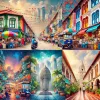Let me tell you, folks, this isn't your typical travel blog. This is a seasoned American backpacker's unfiltered, honest-to-goodness account of a culinary adventure in Yunnan, China that will leave you either drooling with anticipation or recoiling in horror. I've been backpacking for years, seen some incredible sights, tasted exotic dishes, but Yunnan... Yunnan took the cake. Or, perhaps more accurately, the Sapie.
A Pre-Dawn Rendezvous with a Golden Pagoda
My Yunnan odyssey commenced at the ungodly hour of 5 AM. Now, I'm not one for early mornings, but even my sleep-deprived self was captivated by the Mang Shi Meng Huan Golden Pagoda at sunrise. Most tourists see it bathed in the midday sun, or glittering under the night lights. But the pre-dawn stillness, the soft, ethereal light gently caressing the gold, painting the pagoda in shimmering shades – that's a sight you won’t forget. However, my early pilgrimage wasn't solely for aesthetic appreciation. No, sir. I had a date with destiny – a date with a bowl of raw Sapie.
The Allure of Hu La Village Market: A Sensory Symphony
An hour's scenic drive from Mang Shi deposited me in Hu La Village, a seemingly unassuming rural community in Zhafang town. Unassuming, yes, until you experience its vibrant Sunday market. It was a kaleidoscope of sights, sounds, and smells – a sensory symphony of activity. Vendors were a blur of motion, some packing up their wares, others meticulously arranging their displays. The sheer volume of people surprised even my seasoned traveler’s eye. Later I learned the village's strategic location – a vital crossroads between major routes – made it a regional hub.
The Sapie Quest: A Raw Deal with Delicious Consequences
My quest for Sapie led me to a humble, almost rustic room – not exactly a Michelin-star establishment. The air throbbed with the intoxicating aroma of sizzling meat, mixed with something… well, unusual. I quickly learned that Sapie isn't just a dish; it's a participatory experience. You select your own raw meats – a thrilling gamble, let me tell you. My choices? Beef brisket, promising a tender chew; tripe, for that adventurous textural contrast; and some intensely dark innards that I hoped, fervently hoped, wouldn’t haunt my dreams. I also grabbed some beef skewers for grilling – a little something familiar to balance out the raw adventure.
Deconstructing Sapie: A Deep Dive into Ingredients
Let's delve into the components of this culinary enigma. Sapie is more than the sum of its parts; it's a symphony of contrasting flavors and textures:
| Ingredient | Detailed Description |
|---|---|
| Choice Cuts of Raw Beef/Tripe | The customer's selection is key! I opted for brisket, tripe, and some dark, mysterious innards (turned out to be delicious!). |
| The Infamous Bitter Water (Ku Shui) | A dark, almost viscous broth, brewed from boiled cow intestines. Its bitterness is initially off-putting, but strangely addictive. |
| The Aromatic Condiment Blend | A potent mix of local Yunnan spices and herbs – I particularly remember a wild onion called Xiang Liu, lending a sharp, pungent aroma. |
| Pre-cooked, Chilled Rice Noodles | These provide a delightful textural counterpoint to the raw meat and bitter broth. A touch of cool calm in the culinary storm. |
The bitter water, initially a bit of a shock, adds unexpected depth and complexity, and the balance between grilling some meats and boiling others, along with the judicious use of condiments, creates a unique flavor profile.
The Sapie Experience: A Sensory Rollercoaster
That first bite of raw Sapie? Let's just say it was a sensory rollercoaster. The raw beef had a distinct, almost gamey flavor, intensified by the bitter water and the pungent herbs. It was a complex interplay of bitter, salty, and – surprisingly – refreshing flavors. It wasn't what I anticipated, but in the best possible way. It was a culinary adventure, a baptism of fire (and bitter water). The raw aspect was undoubtedly the most intense; the Xiang Liu, in particular, left a lasting impression.
Beyond Sapie: Hu La Village's Unexpected Charms
My morning in Hu La Village extended far beyond the Sapie experience. The market itself was a spectacle – a heartwarming tableau of locals sharing meals, grilling their own meats alongside bowls of Sapie, and exchanging stories and laughter amidst the morning's bustle. It was a glimpse into daily life, far removed from the tourist trail.
A Sacred Bodhi Tree and the Whispers of a Hidden Hot Spring
Venturing further, I discovered a breathtaking Bodhi tree, a revered focal point for the villagers. Its ancient roots and sprawling branches entwined with a small, ornate shrine, creating a captivating scene of serene beauty. The contrast to the market's energy was striking. Not far off, I stumbled upon a hidden natural hot spring, nestled beneath the immense canopy of another colossal tree. Locals, carrying baskets and towels, paid a minimal fee for sanitation and enjoyed a tranquil soak in the naturally heated waters – a secret oasis of relaxation.
Mang Huang Village and a Jingpo Culinary Journey: Hand-Pulled Rice and the Elusive "Ghost Chicken"
My culinary exploration continued at Mang Huang Village, home to the Jingpo people, one of the many fascinating ethnic groups residing in the Dehong Dai and Jingpo Autonomous Prefecture. Here, I experienced the unique culinary tradition of Jingpo hand-pulled rice (Shou La Fan). The rice itself, cooked in bamboo tubes, was served on banana leaves – a testament to the region's commitment to natural simplicity. The accompanying dishes were equally intriguing, including the enigmatic “Ghost Chicken,” a dish with a rich history and flavor as captivating as its name (apparently linked to ancient Jingpo spiritual practices).







